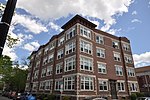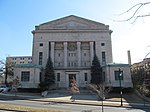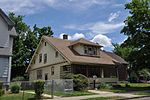Federal Square Historic District (Springfield, Massachusetts)
Historic districts in Hampden County, MassachusettsHistoric districts on the National Register of Historic Places in MassachusettsNRHP infobox with nocatNational Register of Historic Places in Springfield, MassachusettsSpringfield, Massachusetts ... and 1 more
Use mdy dates from August 2023

The Federal Square Historic District is a historic district encompassing a portion of the former Springfield Armory in Springfield, Massachusetts. Located across Federal Street from the main Armory grounds, Federal Square was the site of some of armory's early facilities, including a Continental Army magazine during the American Revolutionary War. It was also the site of a brief clash in Shays' Rebellion, in which four rebels were killed. The district was added to the National Register of Historic Places in 2019. It is currently being developed by Springfield Technical Community College as a technology business center.
Excerpt from the Wikipedia article Federal Square Historic District (Springfield, Massachusetts) (License: CC BY-SA 3.0, Authors, Images).Federal Square Historic District (Springfield, Massachusetts)
Federal Street, Springfield
Geographical coordinates (GPS) Address Nearby Places Show on map
Geographical coordinates (GPS)
| Latitude | Longitude |
|---|---|
| N 42.109166666667 ° | E -72.577777777778 ° |
Address
Federal Street
Federal Street
01101 Springfield
Massachusetts, United States
Open on Google Maps









